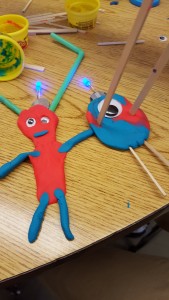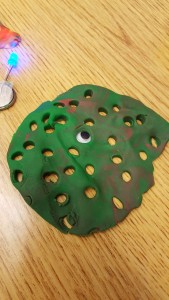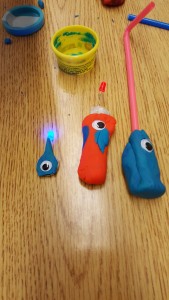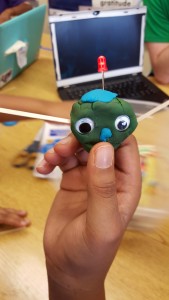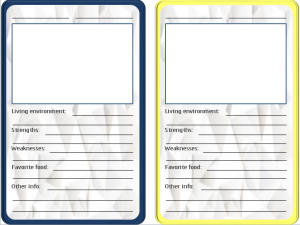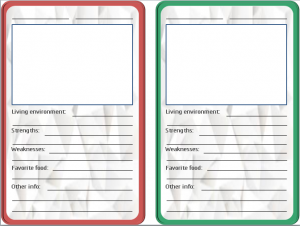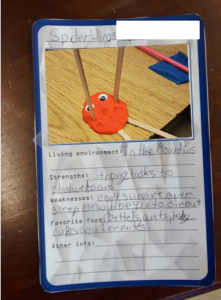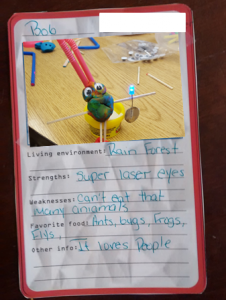Fourth School Visit (December 10th, 2015) – Prototype #4
Nov 30th, 2015 by lanej5
Description:
For the fourth school visit to Troy Public School 2, my group brought our final prototype to try with the fifth graders. This activity was very similar to our third visit prototype. However, we added new aspects to our activity in order to tailor to the past requests of the students and teachers. We used playdoh once again to gain the interest and attention of the students to incorporate an educational concept of adaptation and evolution into the activity. This time however, the students were able to bring home their masterpieces!
Activity:
Since we asked the students about birds last visit, we decided not only to ask about a different species, but to provide a visual guide to this brief activity. We brought in a poster of cats of the world that allowed them to point out a wild cat that they know and the physical differences between the cats. From here we explained the idea of adaptation and how this occurs in the world we know today. Then the group is split in half and kits are distributed for the students to make their aliens. From here the students will make adaptations to their aliens in order to survive in the new environment that they are being shown. Then one of the RPI students takes a photo of their alien and formats it and prints it. Meanwhile the students fill out their own personal alien cards. When they’re filling out the cards, we use this time to re-enforce some useful vocabulary. We also brought a vocabulary poster to help them visually learn these words. After, the students are able to take home their cards!
Interacting with the Students:
For this visit we had two groups of fifth graders. However, unlike the past two times, the groups were not mixed and were separated by gender. The first group consisted of seven girls. It was fairly easy to calm the students down and have them focus on the activity. When prompted with the cats poster, a lot of the girls just yelled out their answers. One girl raised her hand and waited until she was called on. But overall, the girls were enthusiastic about guessing all the different types of cats and were eager to name of the reasons why they were unique from each other. When the girls were split up into groups, Zeke and Daisy announced what environments that their groups would be doing. One of the girls didn’t see our activity last time and one of the girls said to her, “Last time we did oceans. So just wait it’s really fun!”. One of the girls that did do the activity last time exclaimed, “We did this last time!” when Zeke said that they would be making aliens. When the students found out that half of them were doing mountains and half were doing caves there was a bit of chaos. The girls doing the mountains were thrilled, but the girls doing the caves were disappointed and were slightly teased for getting the mountains. However, Zeke quickly explained to them that the caves were just as exciting for the mountains because they weren’t your ordinary caves. This dissolved the situation and the activity proceeded smoothly. Zeke’s group when asked what color LEDs they wanted quickly yelled out “Blue!”. As the caves became darker and they arrived to the glowing cave environment, all of the girls stuck their LEDs in their aliens. When prompted about this, they explained to Zeke that the LED helped the alien see its friends and its enemies. Halfway through the activity, one of the boys from the other activity came over and squished one of the girl’s aliens when she showed it to him. She quickly yelled at him and glared. This showed that the students quickly became attached to their creations and had a personal attachment to their work. When it came to the alien cards, some of the girls were enthusiastic about the cards and even asked to bring them along to the next activity. Others were quite indifferent and ended up leaving them on the table before wandering away. A couple of the girls decided to not make any cards.
The second group consisted of eight boys and they were harder to calm down and to focus their energy on the activity. The boys were not as interested about learning about the reason behind the differences of the cats from around the world. When the kits were distributed, a couple of the boys decided that they wanted to be the aliens themselves. They would stick googly eyes on their face along with some playdoh. However, despite the distracted behavior in the beginning, after a couple of minutes the boys started to really focus on making their aliens. They were very eager to have pictures taken of their alien and would rush to add more things before the picture was taken. When it came to the cards, it was similar with the group before. The group had mixed reactions to the alien cards. Some asked if they could personally draw in the alien, rather than putting a printed picture there. A couple did not want to fill out the cards. But a majority filled out the cards.
An observation that my group noticed was that Daisy had a very easy time interacting with the first group of students (all girls) and Zeke struggled for them to listen to him or to talk with him. However, this scenario was switched when the group of boys came to our table. The boys were drawn to Zeke and held up their creations for him to look at. Daisy’s group at time ignored her request for them to sit down and a couple of them made themselves into aliens. We wondered afterwards if it had to do with the groups not being mixed this time and that the girls tended to connect personally with Daisy more than the boys did with her and that the boys were able to connect with Zeke more easily than the girls.
What worked:
Once again, the playdoh was a success. It reeled in the students and focused their attention for thirty minutes. In addition, for the group of girls the posters were useful. The girls were able to point out the different physical characteristics and later on when filling out their alien cards, they used some of the vocabulary words listed on the poster.
What to improve in the future:
In the future, we would want the groups to be mixed again to see a more mixed gender behavior. In addition, during our visit, we had to print in black and white, but for future uses the pictures would be in color. Looking back at this visit specifically, we acknowledged that our activity was extremely ambitious to achieve in only thirty minutes with the students. Ideally, an hour would be preferable with this activity. It would avoid the RPI students rushing through the alien cards and it would allow the vocabulary to be worked into the lesson plan more.

